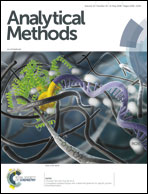Pulsed amperometric detection of pharmacologic adulterants in dietary supplements using a gold electrode coupled to HPLC separation
Abstract
The enlargement of the dietary supplement market has been observed in several countries around the world. However, the increasing consumption of these products raises concerns about their quality and safety. Considering the current scenario, the aim of this study was to develop a new method for screening of multiclass drugs as possible adulterants of dietary supplements. Six drug classes (stimulants, anorexics, anxiolytics, antidepressants, diuretics and laxatives) were studied by high performance liquid chromatography using a biphenyl stationary phase and a gold disc as the working electrode for pulsed amperometric detection (HPLC-PAD). A detection potential of +0.8 V proved to be more appropriate for the detection of all the drugs. A mobile phase consisting of 10 mmol L−1 ammonium acetate in 64% (v/v) methanol at pH 4.0 (isocratic system), 1.0 mL min−1 and 40 °C was used as the optimal conditions for chromatographic separations. Fenproporex, amfepramone, yohimbine, caffeine, sildenafil, tadalafil, furosemide, sertraline, fluoxetine, lorazepam, clonazepam, midazolam, diazepam and bisacodyl were separated after a 25 min chromatographic run. The limits of quantification ranged from 0.13 mg L−1 (fenproporex) to 8.25 mg L−1 (amfepramone), and accuracies from 86.24 to 114.82%. Ten samples of dietary supplements were analyzed, in which caffeine and yohimbine were determined among the studied drugs.



 Please wait while we load your content...
Please wait while we load your content...